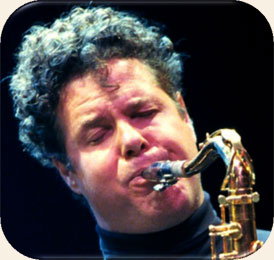Kenny Garrett jamming on alto sax.
Jeff “Tain” Watts on drums
Nat Reeves on bass
Kenny Kirkland on piano
Thanks to Fred for finding this!
Kenny Garrett jamming on alto sax.
Jeff “Tain” Watts on drums
Nat Reeves on bass
Kenny Kirkland on piano
Thanks to Fred for finding this!
By Neal 4 Comments
Best known as the tenor saxophonist of the Saturday Night Live Band, Lenny Pickett is one of the virtuosos of the altissimo register.

The altissimo register is a technique almost seen as a requirement in today’s jazz environment. It’s based on harmonics and enables you to achieve notes above the normal range of the saxophone. For example, it is possible to finger a low Bb (the lowest note on the instrument) and by changing the configuration and position of the tongue in reference to the reed and throat blow the full overtone series of the low Bb (middle Bb, middle F, high Bb, high D, high F, and so on.) This technique can be heard clearly in the well known opening theme to Saturday Night Live.
Lenny passes says this about his equipment, in response to numerous inquiries: “I play a Selmer Paris Mark VI tenor (circa 1970) with a Berg Larsen 130 over 0 (SMS) mouthpiece and a number 3 Van Doren (blue box) bass clarinet reed.”
Pickett, born in New Mexico in 1954, is competent not only with saxophone, but also with flute and clarinet. After dropping out of high school in Berkeley, he spent a brief period studying under Bert Wilson, but amazingly, other than that instruction is entirely self taught on the saxophone. Not viewed as a traditional jazz player, he is best showcased in short bursts of color bringing the life of his horn to center stage in R&B and rock arrangements. He is well known for his funky style, and his ability to make the sax “scream.”
Pickett played with the Tower of Power horns from 1972 to 1981, and toured the world with the popular group. Tower of Power still tours extensively today, though without Pickett. They released multiple Top 100 albums over the course of Pickett’s career with them. Tower of Power played in many styles, from soul to funk to disco, and Pickett’s virtuoso playing felt at home in all of them.
Joining a band will make you better as a saxophone player. It gets you experience playing in front of people and with the other people in the group.

Scope around for different places that you can play- could be a community college band, jam session, or just talking to people and finding other musicians.
If you’re not as good as the other people in the group….. that’s good! It means you can learn from them. Just keep a humble attitude and try and improve and it will make it more fun for them to play with you.
Try out different styles too, if it doesn’t work out, you’ll still make some connections and hopefuly have some fun.
Sax players are used a lot in blues, jazz. Sometimes in classical, R&B, reggae, salsa, and many other styles.
By Neal 2 Comments
Charles Mingus on bass
Don Pullen on piano
George Adams on tenor saxophone
Gerry Mulligan on bari sax- he comes in at about 1:48
Benny Bailey on trumpet
Danny Richmond on drums
Live at Montreux 1975
By Neal 12 Comments
Saw a link to this movie trailer. Not sure where it’s shot, but it has Maceo Parker in it! And I love his sound.
Tenor player gets up on stage and you hear an alto. But it might be in the imagination of the European guy, I’m not sure.
It wasn’t long before successful musicians heard Curtis play and wanted him for their albums. He recorded the saxophone parts for the Chuck Willis song What Am I Living For and the Clyde McPhatter song A Lover’s Question. His breakthrough performance came when he recorded Yackety Yak with the Coasters. Following his impressive performance on that album, his staccato laced style would come to be known as “yackety sax.” Curtis felt that jazz wasn’t the best direction for a profitable career in music and fully embraced the opportunity to play on more commercial friendly albums. He recorded Reminiscing with Buddy Holly and released songs of his own, the most notable being Soul Twist and Soul Serenade.
During the mid to late sixties, King Curtis recorded his two most successful songs of all time, Memphis Soul Stew and Ode to Billie Joe. He also led Aretha Franklin’s backing band, The Kingpins during this time. He continued his relationship with the Coasters into the late sixties and spent some time producing albums for other acts, often in partnership with legendary producer Jerry Wexler. Curtis became a popular attraction at rock shows across the world and had the opportunity to play at some of the greatest venues of the time.
In 1971, Curtis contributed the sax break on John Lennon’s song It’s So Hard, which was a track on Lennon’s Imagine album. Sadly, one month before the U.S. release of the album, Curtis got into an altercation on his doorstep when a group of men blocking the doorway to his apartment building refused to move so that he could get in. Curtis was stabbed to death, and the music world lost another one of its greats.
You don’t need to be a fan of the saxophone to have heard King Curtis’ music; you only need a pulse. King Curtis was one of the best saxophone players in the early rock and roll and soul scene and he contributed to many albums in his day.
King Curtis’ desire to play saxophone came at the age of ten when he first heard Louis Jordan play. He told his adoptive parent’s that he wanted more than anything to play saxophone. His desire hit a fever pitch when he heard the tenor stylings of Lester Young.
When he was 11 years old, his parents presented him with an alto saxophone, which he began playing in the junior high band. Curtis switched to the tenor when his school band needed a tenor player. When he was 16, he started his own band and was playing at parties and dances. Heavily influenced by Texas tenor players like Illinois Jacquet, Earl Bostic and Arnett Cobb, he was at home with rhythm and blues, pop, and jazz music.
In the liner notes to one of his albums, Curtis described his influences in greater detail: “I liked Gene Ammons, Dexter Gordon, Lester Young and Sonny Stitt as well. I also dug Ben Webster and Coleman Hawkins for ballads, Getz for facility, Charlie Parker for technique. Another guy that influences both myself and Ornette Coleman was a Texas tenor man called Red Connor, who was a Coltrane ahead of his time.”
In 1942 Charlie Parker left Jay’s band to play with Earl Hines’ band. A band that included Dizzy Gillespie on trumpet. A musician’s strike from 1942-1943 has made it difficult to document much of what happened during that period. We do know, however, that in that year Paker played with a group of young musicians who embraced the new bebop form of jazz. This group of musicians included not only Parker and Gillespie but other soon to be legends, such as Thelonious Monk, Charlie Christian and Kenny Clarke.
During these formative years of the genre, most of the older, established jazz musicians did not embrace it. Some, however, such as Coleman Hawkins and Benny Goodman, appreciated the new art form, playing and recording with bebop stylists. The genre which Charlie Parker all but invented, had arrived.
Charlie was famous for showing up to gigs without an instrument and borrowing one from somebody else at the last minute. For this reason, he could be seen playing many different makes and models of sax. These include Conn 6Ms, Selmer model 22s, and 26s, and even a Grafton plastic saxophone. In 1947 he had a King Super 20 made exclusively for him. He seemed to prefer Brilhart mouthpieces, having used both Ebolin and Tonalin Streamlines. According to rumor he used hard Rico reeds early in his career but later switched to a 2 ½ in the fifties.
King Curtis on tenor sax, he comes in at about 3:25 after the groove has been going for a while.
The song is ‘Memphis Soul Stew’
King Curtis was put in the Rock and Roll Hall of Fame on March 6, 2000.
Hey Neal,
I’ve just returned to sax playing after not playing for a couple of years and I’m finding getting my embouchure just right and comfortable the most frustrating thing at the moment. my long note practice is quite painful, but its only been a couple of weeks…. previously i played for years as am a classically trained flautist also. but i have set myself a goal to get back to my previous high standard within a few months… so thats a lot of practice!!
Any advice is always appreciated
regards
Anita
_______________________________________________
Hey Anita,
Yep, that can be frustrating. Are you taking breaks while you play? Going constantly isn’t good for you. I kind of buzz my lips and massage them a little bit if they’re getting tired too. I took some classes with George Young and he emphasized taking breaks. He practices many hours every day, and he’s been doing it a long time.
Don’t overdo it, you don’t want to hurt yourself….
-Neal
_______________________________________________
hey Neal,
yep I’m taking breaks…. I play for about 20 minutes then break for 20 then play again for 20 etc… I’m trying to do 2/3 hrs a day broken up…. lips are getting less painful now and the sound is better.
I’m loving the info your sending me!!!! ……….
anita


Want to play saxophone, but feeling lost and not sure how to get started?
In this online/downloadable class you will see methodical lessons in a sequence and you can get feedback and ask questions at any point.
Learn more
Want to take your playing to the next level?
You’ll learn fundamental saxophone skills, building past the basics. Master rhythms. Learn about phrasing, tone, and more. Here you will get feedback which is crucial to developing good habits.
Learn more